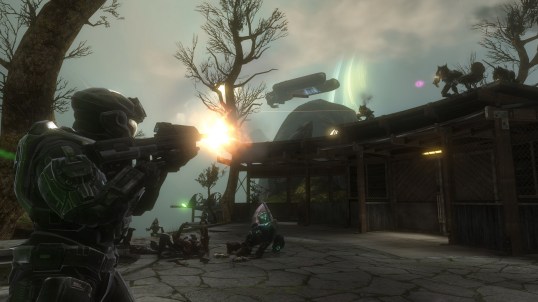Halo: Reach
Publisher: Microsoft Game Studios
Developer: Bungie
Systems it’s available on: Xbox 360
ESRB rating: M for Mature
System reviewed on: Xbox 360
Chances are, you won’t be able to escape mention of Halo: Reach this week. The new video game will surely rack up hundreds of millions of dollars, and most gamers already know whether they’re going to buy it or not. But this game asks a particular question: what does Reach mean?
If you’re completely new to the series (don’t laugh, fanboys, it’s true for someone), Halo‘s a science-fiction first-person shooter series where players inhabit the armor of future cyborg soldiers called Spartans. The first three Halo games had you controlling Master Chief–last of the Spartans–as he led the charge in humanity’s war against a collective of alien races called the Covenant. Halo: Reach is a prequel to those games and the last title that series’ originators–the development studio Bungie–will be working on. (Microsoft retains the rights to Halo and the franchise will continue under the auspices of a to-be-announced developer.)
(More on Techland: Bungie Partners With Activision for New IP [Update X 2])
Now that the newbies have the basics, let’s talk about Halo‘s influence. For my part, I’ve never been a crazily passionate Halo fan. As a game critic, I had to engage with the perennial releases with a mix of exasperation and dread. No matter how anybody feels about the games Bungie’s been making over the last three-quarters of a decade, one has to admit that they’ve all been daunting heaps of content. After my preview sessions with Halo: Reach a few weeks ago, I mentioned to a fellow critic how surprisingly good my time with the game was. His response was to say, “The games have never been bad; they just have outsize influence.”
He’s right. Halo‘s been the Xbox’s marquee franchise ever since Microsoft got into the console business and each one’s been symbolically super-important to the tech giant’s video game ambitions. The first game, Halo: Combat Evolved, delivered to a console the kind of sharp, fast first-person shooter action that PC fans had been enjoying for years. Similarly, Halo 2 brought the culture of online game competition to a wider audience than ever before. By the time Halo 3 rolled around, the record-breaking sales numbers it posted seemed like an inevitability. And, in the time since Combat Evolved came out, a legion of rabid fans, elite professional gamers and adherents dedicated to competing consoles (like the PS3) have all codified their identities as gamers in either allegiance or opposition to Halo. So it’s easy to lose focus on the stones that create these huge ripple effects, which is to say the games themselves. Previous games have been straightforward blasts of bombast, with the terse Master Chief grimly facing down hordes of aliens. (Last year’s Halo: ODST took a Rashomon-style approach to its story, but felt very similar to the first three games.) Reach is atypical. It goes somewhere different and gets there in different ways.


